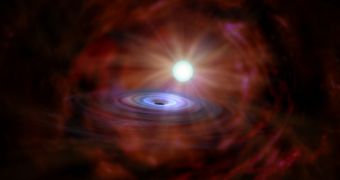In a recent paper, scientists at the University of Michigan describe the discovery of an extra-luminous black hole system in the Pinwheel Galaxy, a cosmic formation located very close to the Milky Way, at just 22 million light-years. The system appears to be much brighter than scientists expected it to be.
The discovery, detailed in the November 27 issue of the top scientific journal Nature, may force astronomers to reinterpret some of the theories used to describe how black holes radiate light and heat.
The object the new analysis centered on is called ULX-1, and it consists of a large black hole feeding on a luckless companion star. As material from the latter spirals through the event horizon of the black hole, huge amounts of X-rays are produced and scattered throughout the system's surroundings.
ULX is an acronym that stands for ultra-luminous X-ray source. Within this class of objects, Pinwheel's ULX-1 reigns supreme in terms of brightness. Like all other black holes, it accumulates matter through an accretion disk, where matter is heated up to millions of degrees. This forces it to emit radiations.
“As if black holes weren’t extreme enough, this is a really extreme one that is shining as brightly as it possibly can. It’s figured out a way to be more luminous than we thought possible,” U-M professor Joel Bregman said in a recent statement. He is a co-author of the Nature paper.
Astrophysicists proposed some time ago that the extreme brightness of ULX-1 may be owed to the fact that it contains an intermediate-size black hole, a structure hypothesized to exist, but never detected. Such objects are believed to weigh between 100 and 1,000 solar masses, Space reports.
However, the recently studied object sits right on the border between small and intermediate black holes, with some astrophysicists suggesting that it may in fact lie on the small side. Its companion is a hot, Wolf-Rayet-type star, weighing in at around 19 solar masses.
For this study, the system was observed using the Gemini Observatory, the NASA/ESA Hubble Space Telescope and the NASA Chandra X-ray Observatory. The two objects in ULX-1 are so close that they only need 8.2 days to orbit each other. Originally, the system may have included two massive stars.
One of them probably reached the end of its burning cycle, and blew up as a supernova to form the black hole. Precise measurements of this object revealed that it weighs between 20 and 30 solar masses.
“Our findings may turn the trend of taking ultraluminous X-ray sources as promising intermediate black hole candidates,” says study leader Jifeng Liu, from the Chinese Academy of Sciences in Beijing,.
“Our work shows, based on our conclusion of a stellar mass black hole, that our understanding of the black hole radiation mechanism is incomplete and needs revision,” he concludes.

 14 DAY TRIAL //
14 DAY TRIAL //